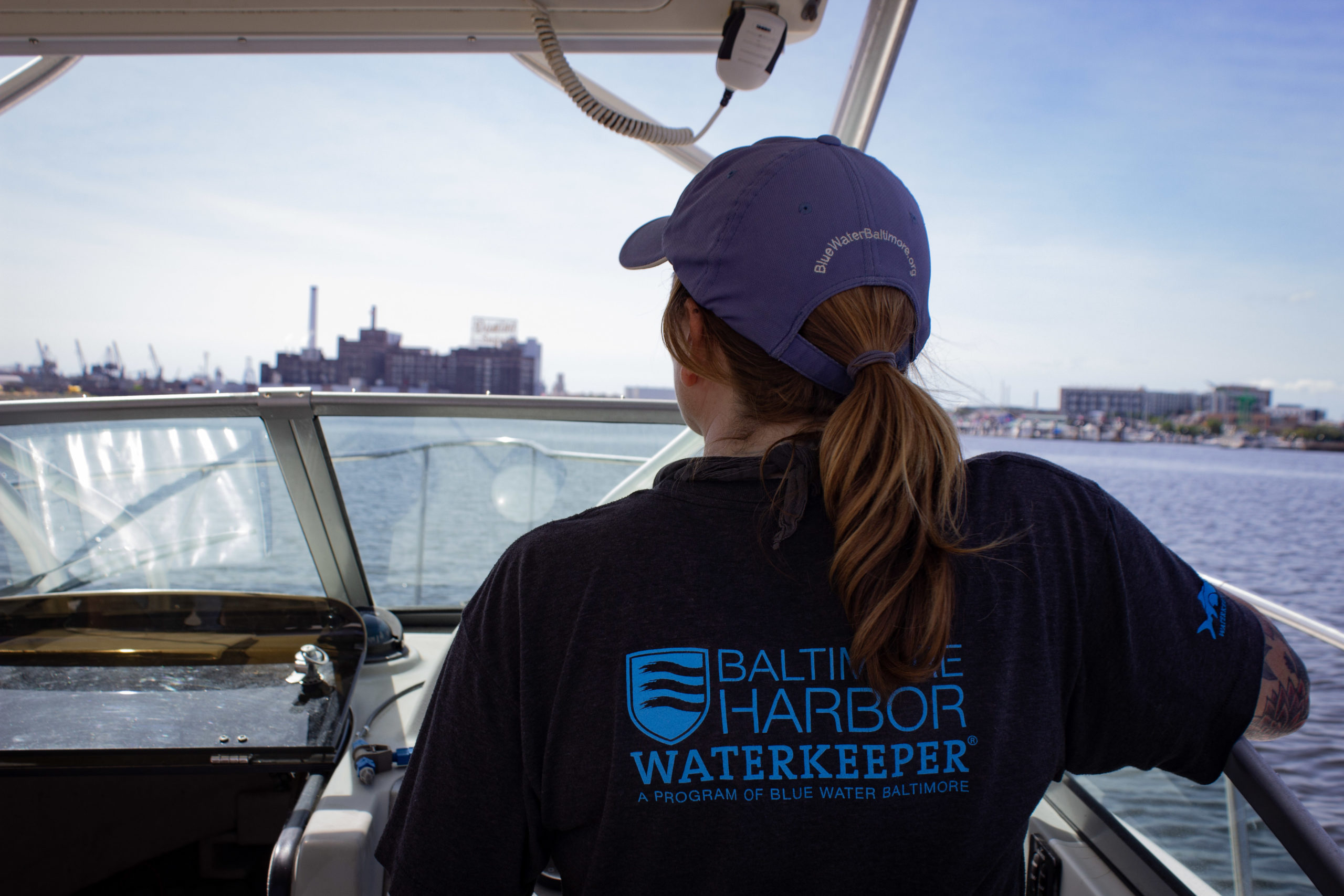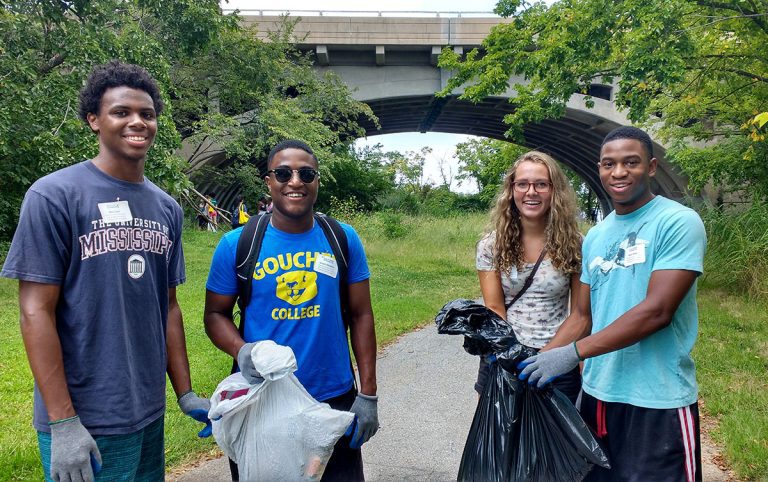Our Water Warriors: The Duo Behind BWB’s Water Quality Program
Winter or summer, rain or shine our science team is out on the water monitoring the quality of our waterways.
Barbara Johnson is BWB’s Water Quality Manager & Cody Matteson is our Senior Coordinator for the Water Quality Program. Together they make the ultimate duo, traversing our streams and harbor to track the progress we’re making toward Baltimore’s clean water future. Whether they’re out on foot or patrolling by boat, Cody & Barbara are keeping an eye out for pollution and other indicators of water health.
Read on to see what drove Cody & Barbara to pursue such fascinating careers in environmental science.
Q1: How did you become interested in environmental research and water quality?
Cody: I have always been drawn to the outdoors and growing up in Virginia Beach I was especially excited by the ocean and bays/estuaries surrounding me. I developed the research interest while attending Virginia Tech and the University of Georgia where I learned exciting techniques scientists use to understand these natural systems.
Barbara: I went back to finish my undergrad later in life, after I already had an established career in another field. The minute I opened an ecology book I knew I had found my place. Water is the root of life. Without clean water we do not have a healthy planet…it affects everything! I wanted to be at ground zero. I volunteered with BWB the last semester I was in school. The minute I stepped into the Gwynns Falls to take that first sample, I thought “this is it, this is where I want to be and what I want to give a voice to”

“this is it, this is where I want to be and what I want to give a voice to” – Barbara Johnson
Q2: What keeps you going while monitoring and advocating for water quality?
Cody: I am fascinated by what data can tell us. Being able to take, for example, bacteria levels and analyze them to see trends like improvements and problem areas really drives my interest. I also love sharing my work and talking with people about what the problems are, why we have them, and possible solutions.
Barbara: When I see people and animals in their communities being affected by pollution, my natural instinct is to inform, protect and give a voice to those who are unheard. The notion that we as humans just get to abuse the planet anyway as we see fit is lost on me. Humans are the one animal on this planet that we know has a documented history to reflect on and learn from. My hope is for us to use that information to protect what sustains life. This is the root of what keeps me going.
Q3: What do you see as the ongoing or final goal of water quality monitoring and advocacy?
Cody: I don’t see there being a final definitive goal. We would like a swimmable and fishable harbor and the resolution of many issues affecting neighborhoods. But I don’t think the work is ever done, even when we’re in a good place we still want to be there monitoring progress and addressing issues as they arise.
Barbara: I really love and believe in BWB’s mission statement. It encompasses so much in just a few sentences. I think the key word is community. The simple act of just listening to and speaking with community members, lending support, and offering action opportunities can have an immense ripple effect in positive ways. I envision community members becoming advocates for clean water through our work, however it fits best into their lives. I see the goal of environmental justice for all, not just for communities that have the time and means to be heard and not just through water quality monitoring. It could be planting trees and other native species, supporting environmental legislation, reporting pollution, environmental education or becoming a member of an environmental organization like BWB; each piece is a very important cog in supporting that mission. Water quality monitoring is the scientific backbone to all those other pieces, it provides a lens into what is working and where we can improve.
“I see the goal of environmental justice for all, not just for communities that have the time and means to be heard and not just through water quality monitoring.”- Barbara Johnson
Q4: What is your favorite memory out on the water?
Cody: I really enjoy mornings on the water, especially when we are further out in larger water bodies. I also enjoy the possibility of every time we go out, we may find something that will enable us to improve water quality, as well as the chance of responding to environmental issues while we’re out in the field.
Barbara: I am not sure I could pick just one! I have been monitoring Baltimore waterways since 2015 and have so many memories. I think if I had to narrow it down, it would be two main things in general. The first being when I work with community members out in the streams, and you see the big picture click in their eyes. You can see they have a meaningful experience and become advocates in their own right. The second would be witnessing all the different wildlife right here in Baltimore’s waterways. The resilience of so many creatures and the ecosystems they depend on to survive are some of the greatest memories seared into my mind.

In addition to the Waterkeeper teams exciting water quality research both Barbara and Cody are published authors of scientific research.
Research for Barbara’s paper was conducted while working towards a bachelor’s degree at the University of Baltimore, under the direction of Dr. Elka Porter. The project is published in the Journal of Marine Research. The work addressed how the presence of Little Neck Hard Clam (Mercenaria mercenaria) affects the erodibility of sediment in streams. Controlled, in lab, experiments were conducted, and results analyzed to assess the shear stress (the force water puts on sediments in streams) and sediment erosion in relation to different densities of clams. Due to bioturbation (clams digging), erosion increased as more clams were added but stabilized over the long term as shear stress decreased and a layer of microphytobenthos (layer of microorganisms on the stream bed) formed. This study provides a starting point for additional research on the long-term effects of clam communities on shear stress and microphytobenthos impacting sediment erosion.
Cody’s published work was developed while completing a Master of Science degree at the University of Georgia under Dr. C. Rhett Jackson and Dr. Susan B. Wilde. The project was funded in part by the Environmental Protection Agency and published in the Journal Wetlands. This work tracked nitrogen and phosphorus in water and soil through a farm, wetland, and into streams. These samples were statistically analyzed to compare nutrient levels between the farm, wetland, and streams. Observations were geared to assess functionality of a wetland as a nutrient sink to soak up and process excess nutrients. The results indicated that much higher levels of nutrients were in soil and water at the farm and entering the wetland, than in the wetland and stream, indicating processing of nutrients in the wetland. This study also sets up future studies at the site to better understand mechanisms in the wetland that are reducing nutrient levels.
Learn more about Waterkeeper team and all our fantastic staff!



